| Sources for this article are Tim Brookes, Joan Witt, Frank Dawson and Frank's newest book Picking Elderberries A Small Town Story. Many thanks to all three. |
This began as a result of a email sent to the East Liverpool Historical Society on December 28, 2010.
Request Information
The newspaper today had Joe McNicol's Obituary. In his obituary he was born February 17, 1934 in East Liverpool. It stated that he livid in the "Irishtown" area of East Liverpool.
I am not aware of the area in East Liverpool was wondering if in your records you knew of this area.
Thank You for your consideration in this matter.
William Cunningham
The email was forwarded to East Liverpool Historical Society President Tim Brookes and Vice President Joan Witt.
Tim Brookes and Joan Witt replied back to us that Irishtown was the area around City Hospital and probably extended eastward to Jackson Street. Joan suggested we ask Frank "Digger" Dawson as well.
Frank's reply was as follows:
See page one of "Elderberries." Joan Witt is correct, it unofficially runs from the area of the Newell Bridge (Golding Street) to Jackson Street and should at the very minimum include portions of West Fourth, West Fifth and West Sixth.
From Page 1 of Elderberries:
One of the first subdivisions of the town to be laid out was the James Blakely addition . . . Surely the ambitious Blakely had visions of grandeur as he painstakingly put together his plan to make the community a mega-city.Unfortunately, Blakely must not have recognized that the natural geographic boundaries created by the river, the hills and the sometimes laid-back attitude of the citizens would impede progress. He persisted, and in early November 1850, traveled by boat from Pittsburgh for the purpose of selling some 30 lots in the addition for a total of $4,550. Indeed, a hefty sum for him and his wife, Suzanne, to take home after having endured what was reported to be two days of bad weather.
It was at this sale that Patrick M. McNicol, Sr., an immigrant from County Donegal, Ireland, bought lot No. 383 for $98.10. He was one of many Irish Catholics who became part of the neighborhood.
After a fashion, a section of Blakely's plat, located between Jackson and Golding Streets, a short stretch running from the present Newell Bridge to City Hospital became known as "Irishtown."
The name of the neighborhood was derived from the heritage of its residents and the Catholic Church that was built on the corner of West Fifth and Jefferson Streets.
The church's name, St. Aloysius, was taken from the Patron Saint of Children, Aloysius Gonzaga, an Italian Jesuit, who lived between 1568 and 1591.
We have the honor of presenting the following:
On October 15 we received an email from Martha McEldowny containing the following:
re: REST IN PEACE PART 4
Flats Cemetery
Most of my relatives are buried in Flats Cemetery. So sorry to find the two pictures are blank. Can anything be done to print the pictures so we may see them?
At some point two pictures of Flats Cemetery had been accidentally deleted from this article on the ELHS Web Site: Rest in Peace Part 4
The two pictures were returned to the above article.
She continued:
re: SIXTH STREET PART 1 (11th picture down, Hans Hacker drawing) I lived at 312 W 6th Street in my grandmother's ( Mrs. James H. Welch) house from 1934-1952. At that time in my younger years, the building pictured was Conant's Grocery.
Here she is referring to the following article - Sixth Street Part 1
Chuck Fluno, before he had his confectionery in the former Conant's, had a small car repair shop at the SE corner of Jefferson and 6th.
I, too, took lessons from Ruth Johnson (a family friend) and remember very well the wonderful aromas of dinner cooking in her kitchen while I learned to play the violin, and also the sounds (and screeches) of boys "playing" their various horn instruments upstairs with Mr. Ralph Johnson.
The area was, in my day, called Irishtown because of St. Aloysius Church, rectory, school and convent, all on Fifth Street. While there were a lot of people from Ireland and England, our neighbors were also immigrants from several countries (Italy, China, Syria, Libya, Greece, several of the Slavic countries) and places I may have forgotten. When I was in Third Grade at Sixth Street School, there was one black child, but she was not there the next year, nor did I see another black person until high school. It was a marvel, I thought, to walk through my neighborhood after school or at dinner time, and draw deep breaths of the aromas offered by the various cuisines and to hear the melodies of the many languages. Truly, after such a multi-cultural upbringing, who could be prejudiced!
Some of our neighbors on Sixth Street were pottery owners Goodwin and Smith, the Ikirt family, the Superintendent of Schools (next door), Dr. Gerace; on Fifth Street the Kerrs of Kerr Lumbar Company and the Methodist parsonage. History from my childhood for what it's worth. Sixth Street, at one time, was a great place to live.
re: CHURCH MYSTERIES AND CHANGES 1
Here she is referring to the following article - Church Mysteries and Changes
When I was young, there was a metal plaque at the main entrance to the church proper that read "Methodist Episcopal Church North." I was told that the plaque had been there during (and after, evidently) the Civil War when the church split over slavery. Not until much later was the plaque removed...and I do not know the date when that occurred...and that institution became the United Methodist Church.
This all may be interesting to only me, but I wanted to pass it along to you because I am certain that you love history as much, even more probably, than I.
Thank you for your dedication to this site and for making it such a great source of information to all of us who love history from the beginning to the latest.
Martha McEldowny, 'way out here in Kansas
We replied to that email to tell her we had put the Flat's Cemetery pictures back into the article and to thank her for her wonderful email. We also included copies of those two pictures in our reply email.
October 21, 2013 we received the following from Martha:
More news from Irishtown
Thank you for your kind words and for your interest in the history I provided. It’s thrilling to know that some of it may be included in future entries of the history of ELO.
Thanks also for the two pictures of Flats Cemetery, and for re-instating them on the web site. Not only am I thankful, but several of my relatives are also grateful, especially a cousin who lives in Industry, PA., a young woman who is also a serious student of genealogy. I enlarged the pictures and there was the name of one of our Mercer ancestors.
My Mercer relatives of the past settled in West Virginia, and my ancestors owned large farms and tracts of land that eventually became a large part of Tomlinson Run State Park in West Virginia. When I was a teenager, my father rowed a boat out to the middle (I think) of the lake made by the dam, and pointed down into the water and asked, “Do you see the chimney?” I did, and he said, “That’s the chimney of the farm house that my grand-parents owned.” While I’m immensely interested in this West Virginia history, I think it has little to do with the history of East Liverpool. So…
Looking over the email I sent, there are a few things I’d like to add. These may fall under the category of “interesting but not relevant” items that you may NOT wish to include on the site, but perhaps you would enjoy knowing.
1) When Chuck Fluno had his small car repair shop at the corner of Sixth and SE Jefferson Street, there was a huge sign over the small building which read “HAS YOUR YIP LOST ITS ZIP?” I never really understood the meaning of that “yip” word, but, nevertheless, somehow it made sense. (???)
2) I did not mean to imply that the neighborhood was filled with the mansions of the wealthy pottery owners and business owners, though there were several, or that my family was among them. The neighborhood was, for the most part, filled with working-class people, and my family was among them. There were a lot of teachers, doctors, and professionals, but most of the families were hard-working immigrants whose work ethic was admirable.
3) I remember the Dallas family from Greece who lived across the street from us, and whose two sons rose to prominence in differing fields. The older son, Demetrious (who escorted me to the Junior Prom) became a noted surgeon at a Youngstown hospital, and the younger son, Constantine, who became, as his father characterized him, “a student in perpetuity who never worked a day in his life,” but who accumulated degree upon degree in the pursuit of knowledge.
4) The Nagem family from Syria also lived across the street. The parents were married in Syria. Sadie, the wife, was madly in love with a younger son of the Nagem family and thought she was marrying him, but when the wedding ceremony was over and later when the veils and dressings were removed, she discovered she was married to the older brother whom she hated and thought ugly. However, he brought her to America. Their older son, George, worked in a steel mill in Midland and, so we learned years later, donated all his earnings to the younger son, Robert, who was extremely bright, the money being saved for Robert’s education.
Late in life, Sadie gave birth to a daughter who became, in every sense of the meaning, “the light of her life,” on whom Sadie doted in the extreme. And indeed, the entire neighborhood doted on Mary who was an unbelievably beautiful child! However, at age four, Mary became ill, diagnosed with leukemia, fatal. She died at age five on the eve of her older brother, Robert’s, valedictorian address to his high school graduating class, which he delivered at his parent’s urging, a valedictorian address that was characterized at the time as “superb!” Years later, when my husband and I returned to ELO for visits, and called on Sadie, she was still mourning Mary’s death. When Robert was present, he was still urging his mother to stop crying and pay attention to their visitors (my husband and me).
Robert graduated from Mount Union College, where he was a member of Sigma Nu and was instrumental in my husband’s affiliation to that social fraternity, and went on to even higher education, earning several advanced degrees, and became a renowned professor at a Wisconsin university.
5) My mother, born in 1899, and her two sisters attended Sixth Street School, as did I and my sister. After I graduated from Ohio Wesleyan University, I taught in several East Liverpool Schools, including Third Street School, Horace Mann, Neville, and…guess where?…Sixth Street School. I know Sixth Street School is gone and I imagine all the others are, too.
6) I mentioned some neighbors of ours on Sixth and Fifth Streets, but neglected to remember some on Fifth Street:
* the Bennett family, descendents of the original Bennett of pottery fame, whose very large house was directly across the street from the Methodist Church. Miss Bennett was the Sophomore Latin Teacher. Eventually, Dr. Hayes bought the Bennett house and converted it into his office for the practice of osteopathic medicine. Later, he bought the Smith mansion on Sixth Street and remodeled it into his Osteopathic Hospital.
* Miss Phyllis Crook’s house (she of the Crook Furniture Company) has been incorporated into the Dawson Funeral Home today. Miss Phyllis was a family friend who entertained us many afternoons with tea, and I mean a real tea with scones and jam and small decorated cakes. She had a woman companion to see to the house and take care of her, and despite her millions, she never traveled more than the few miles to Pittsburgh and back. She often informed us that “money is always a good gift,” and related that she and a cousin, also a millionaire, always traded $20 checks as gifts on special occasions. She left one of her millions to the United Methodist Church across the street from her house.
* Starting at the corner of Fifth and Jefferson going west on the north side of the street, there was a house whose occupant I do not remember. (The house is no longer there.) The next house was the Methodist parsonage, the next was the Kerr house (Kerr Lumbar). The next was the Erlinger house of the Erlinger Department Store whose daughter, Doris, had the most beautiful gold-red curly hair I have ever seen even unto this day, and a good friend; and the next was the Tecca house, one of our Italian neighbors. As children, we always pleaded with Dick Tecca to stay on the ground and NOT climb the trestle (of the Sixth Street Viaduct) because he always fell and broke something…arm, leg… and then we would be punished by our parents and forbidden to climb the trestle which always ruined our summer fun.
* On Fourth Street, of course, in a lovely house, lived Miss Gladys DeBolt, a high school teacher.
* Returning to Sixth Street…the Ikirt house. Of course you know about the Dr./Sen. He had one son and four daughters.
The oldest daughter was the only one who married, and she lived out of town. (Sorry, don’t recall her name.)
The second and third daughters were teachers in high school. Miss Olive taught history (she was the one who inspired me to pursue the subject all my life) and Miss Rubina taught English Literature (she was the one who inspired my life-long appreciation of poetry and Shakespeare). Miss Olive caught my attention early on because she had the most beautiful auburn hair I have ever seen, and she “did it up” a different way every single day. She may have repeated her hairstyle every month or two, but I never saw the style repeated during any week of the school year. Amazing!
The youngest daughter, Geraldine, was an opera singer of renown in Chicago. After she returned to ELO, most people thinking that she had lost her position because of drugs (???), she became a voice teacher, my sister being one of her pupils.
The one son, Virgil, was whispered to be a “womanizer,” and in a louder voice, “he never amounted to a hill of beans!”
I remember being in the Ikirt house when my sister was taking singing lessons. We were invited into the music room which was a sight to behold, everything being gold and white, the room filled with musical instruments including two grand pianos and a golden, intricately carved harp. I remember my grandmother relating that there were many grand balls held in the top floor of their house (mansion?) and of all the carriages lining the streets around and about the house. I could imagine what that house and all its rooms must have looked like, if the music room was any indication of the rest of the house in its prime.
7) and last – Skeleton Park. Our favorite playground. There was a sort-of cave part way down the hill at the end of the park. We and all our playmates kept a jar of peanutbutter and a tin of crackers there and watched the Airplane family who lived and worked in the town dump. We could also watch the hobos with their cooking fire under the old Newell Bridge. We decided that the cocker spaniel-sized animals we saw were river rats; we never went down there. Our secret prized possessions were two bones, one of them hanging down part-way from the roof of the cave, and one lying on the floor. We left them there and never told anyone about them.
The Airplanes were a raggedy-dressed family who pushed and pulled a rather large cart around town, collecting trash or anything people were willing to give them. They were filthy looking, hardly any teeth, but always smiling, and we children kept our distance. (It’s anyone’s guess if this was a needed practice.) However, they got the name because the boys who idled around Heime’s on Sixth Street would, on seeing the family, point to the cloudless sky and say “airplane, airplane” and the entire clan would also point to the empty sky, grinning, and repeat “airplane, airplane.” I’m sure they must have had a proper name, but I never knew it.
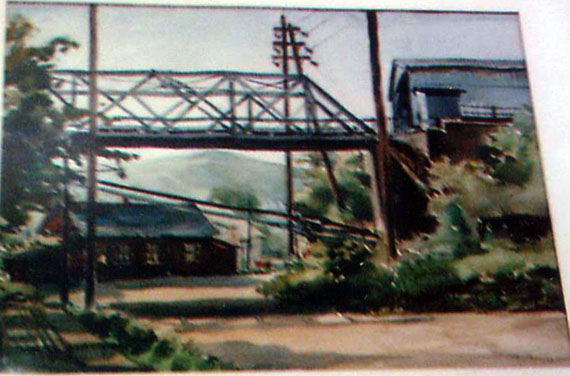
This is the house we believe "Airplane" lived in.
That’s a rather sad note on which to end, but I hope you enjoy knowing some day-to-day news about Irishtown.
Thanks for your interest and thanks for such a wonderful and informative historical site for all of us to profit from.
Martha McEldowney
The following maps show most of what is termed "Irishtown" in ELO.
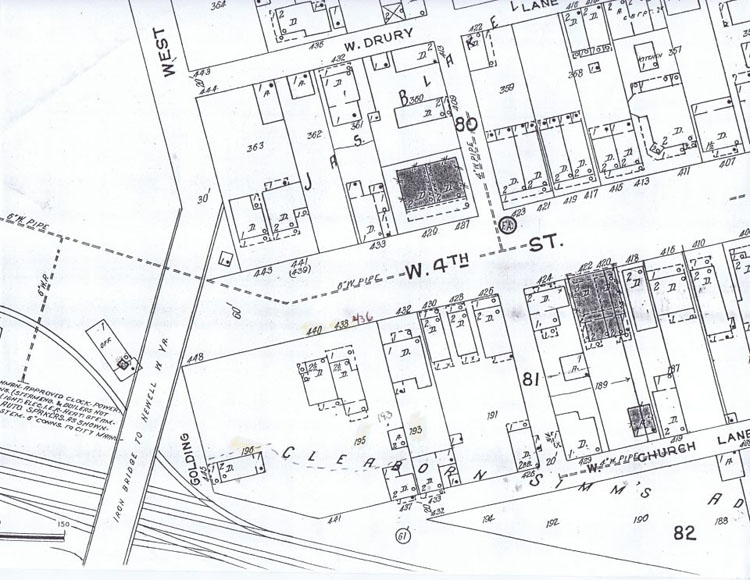
This shows the building (labeled office here) that was to become the place "Airplane" lived, we think.
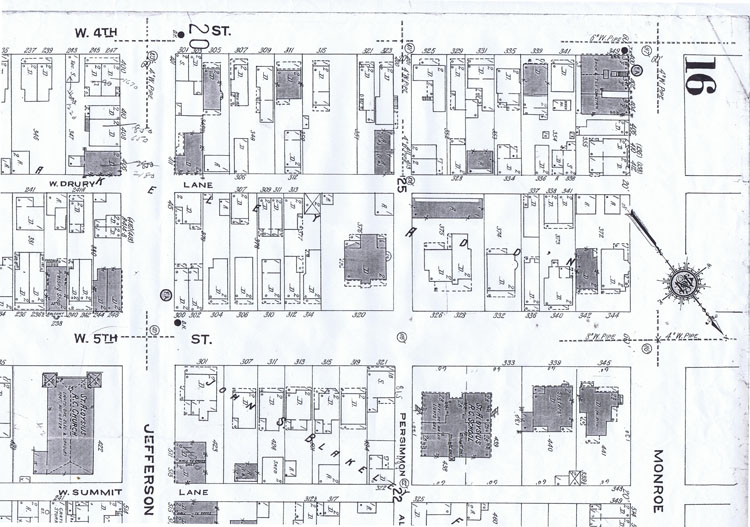
Fourth and Fifth Street Monroe to Jefferson
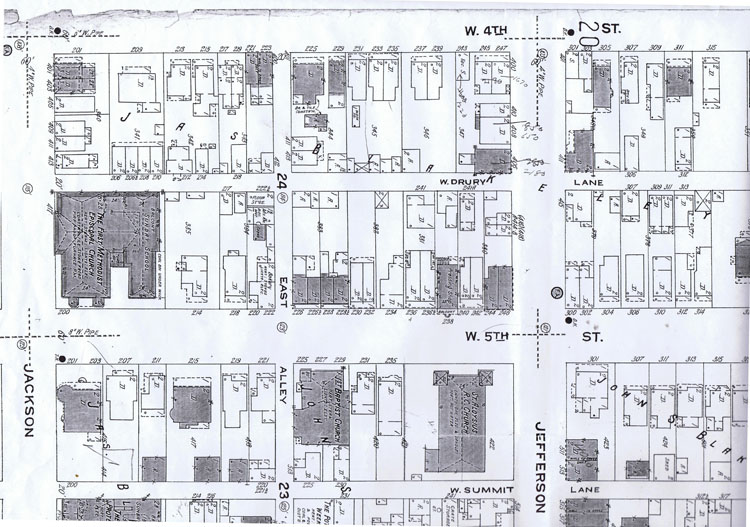
Fourth and Fifth Street Jefferson to Jackson
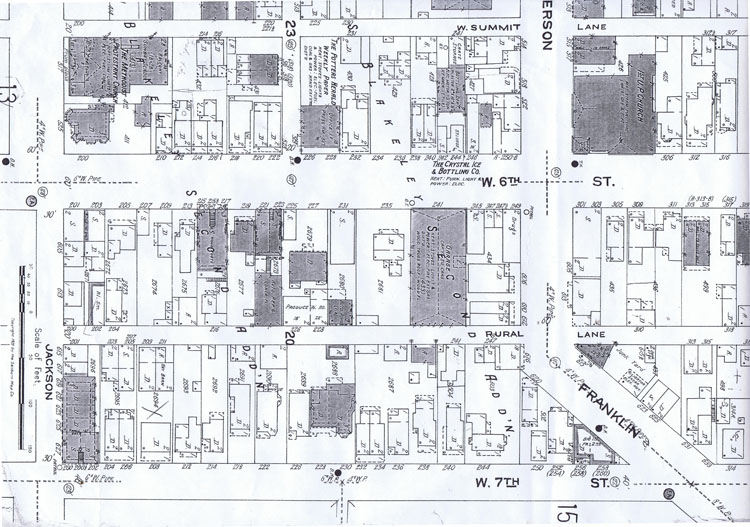
Sixth and Seventh Streets Monroe to Jefferson
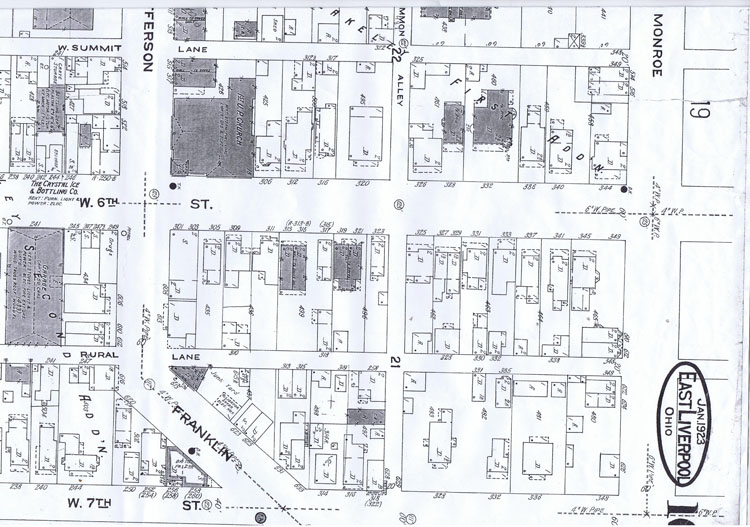
Sixth and Seventh Streets Jefferson to Jackson.
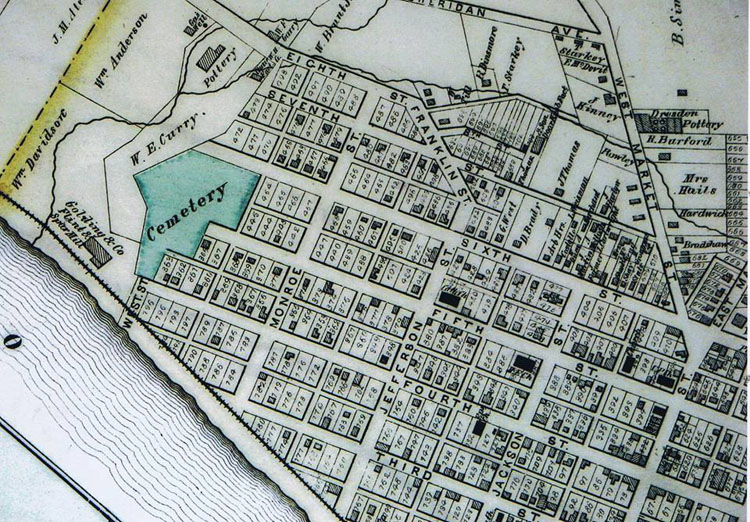
This would be much earlier then the two stores indicate but does show were Skeleton Park was.
This site is the property of the East Liverpool Historical Society.
Regular linking, i.e. providing the URL of the East Liverpool Historical Society web site for viewers to click on and be taken to the East Liverpool Historical Society entry portal or to any specific article on the website is legally permitted.
Hyperlinking, or as it is also called framing, without permission is not permitted.
Legally speaking framing is still in a murky area of the law though there have been court cases in which framing has been seen as violation of copyright law. Many cases that were taken to court ended up settling out-of-court with the one doing the framing agreeing to cease framing and to just use a regular link to the other site.
The East Liverpool Historical Society pays fees to keep their site online. A person framing the Society site is effectively presenting the entire East Liverpool Historical Society web site as his own site and doing it at no cost to himself, i.e. stealing the site.
The East Liverpool Historical Society reserves the right to charge such an individual a fee for the use of the Society’s material.